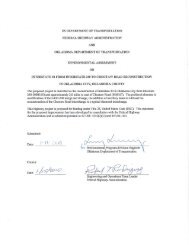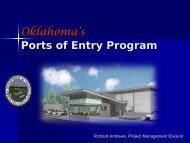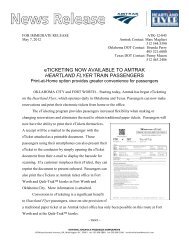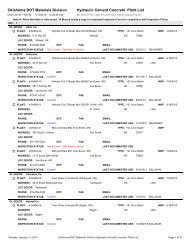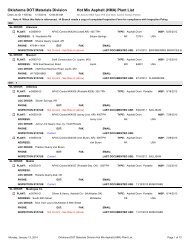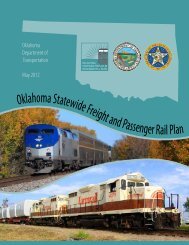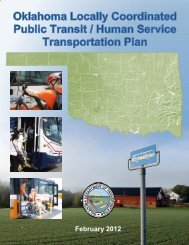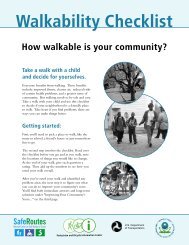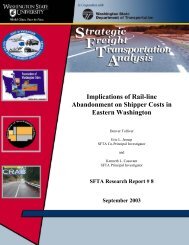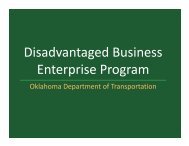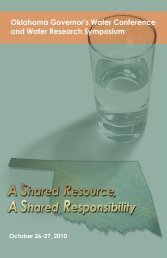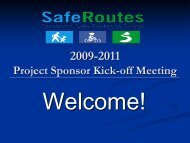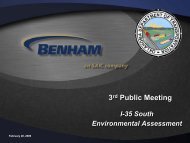Benefit Cost Analysis Technical Memo - Oklahoma Department of ...
Benefit Cost Analysis Technical Memo - Oklahoma Department of ...
Benefit Cost Analysis Technical Memo - Oklahoma Department of ...
You also want an ePaper? Increase the reach of your titles
YUMPU automatically turns print PDFs into web optimized ePapers that Google loves.
Economic benefits <strong>of</strong> the project have been estimated at year 2009 price levels. The benefits<br />
include:<br />
(1) Fuel savings, quantified<br />
Failure to implement the project is assumed to result in withdrawal <strong>of</strong> rail service after two<br />
years, as noted in the introduction to this Section. The No Build scenario would result in all<br />
freight otherwise shipped by rail having to be shipped by truck. The consequent increase in<br />
trucking will result in greater use <strong>of</strong> motor fuels, because <strong>of</strong> the relative inefficiency <strong>of</strong><br />
diesel or gasoline-fueled trucks compared with diesel-electric rail locomotives.<br />
Assuming all trucks would be diesel-fueled, the excess fuel use if the current level <strong>of</strong> rail freight<br />
service were to be withdrawn would be 653 thousand gallons in 2012, growing to 1.293 million<br />
gallons in the year 2029. The value associated with these fuel cost savings has been<br />
accounted for in the corresponding shipping cost estimates, which are summarized for selected<br />
years in Table 4 later in this report.<br />
(2) Customer (Shipper) cost savings, quantified<br />
The project will result in small reductions in rail Operating & Maintenance (O&M) costs, which<br />
are not assumed to be passed on to customers. Because failure to implement the project will<br />
result in withdrawal <strong>of</strong> rail service within the project area after an assumed two years, the No<br />
Build alternative would result in freight otherwise shipped by rail having to be shipped by truck.<br />
Trucking is more expensive than shipping by rail; benefits accrue to customers as a result <strong>of</strong><br />
lower shipping costs via rail. The project, by preserving and improving rail freight service, would<br />
save customers an estimated value <strong>of</strong> $9.7 million in 2012, compared with the cost <strong>of</strong> shipping<br />
by truck. This amount is projected to grow to $14.5 million annually by 2015 and to $18.9 million<br />
annually by 2029.<br />
(3) Greenhouse gas emissions (reduced), quantified<br />
The increase in trucking in the No Build alternative will result in increased emissions <strong>of</strong><br />
greenhouse gases. Diesel or gasoline-fueled trucks are relatively inefficient compared with<br />
diesel-electric locomotives and the lower energy per ton-mile required when moving freight via<br />
rail. Greenhouse gas (measured by CO 2 ) reductions are projected to be 26.7 thousand tons in<br />
2012, rising to 52.8 thousand tons by 2029. The benefit at $7.00 per metric ton grows from $187<br />
thousand to $370 thousand per year, between 2012 and 2029.<br />
(4) Public health benefits<br />
As discussed, the No Build alternative would see all freight otherwise shipped by rail having to<br />
be shipped by truck. The consequent increase in trucking will have an adverse effect on air<br />
quality within the corridor, and may also result in localized noise increases. The economic<br />
benefit <strong>of</strong> air quality improvements (measured by HC, NOx, and PM10) <strong>of</strong> the project gradually<br />
declines from $174 thousand in 2012 to $12 thousand in 2029, as more stringent regulations<br />
result in cleaner diesel exhaust.<br />
(5) Other costs and benefits related to vehicle miles <strong>of</strong> travel<br />
The project will result in road traffic vehicle-miles-<strong>of</strong> travel (VMT) reductions as compared to the<br />
No Build alternative. There would be consequent savings in road maintenance and operating<br />
costs that would result from avoided road deterioration. Also, there would be improved traffic<br />
safety, producing reduced accident costs. Road maintenance expenditures anticipated to be<br />
eliminated by the project amount to $1.2 million in 2012 and $2.3 million by 2029. Accident<br />
costs are projected to be reduced by $2.9 million in 2012 and $5.8 million in 2029, assuming no<br />
changes in accident rates over this period.<br />
4




